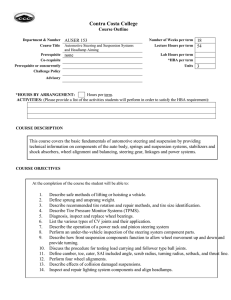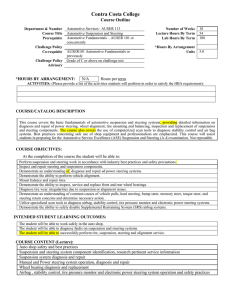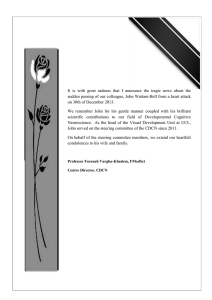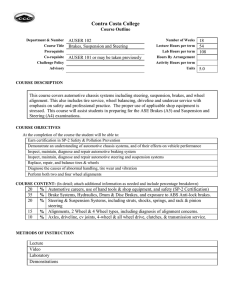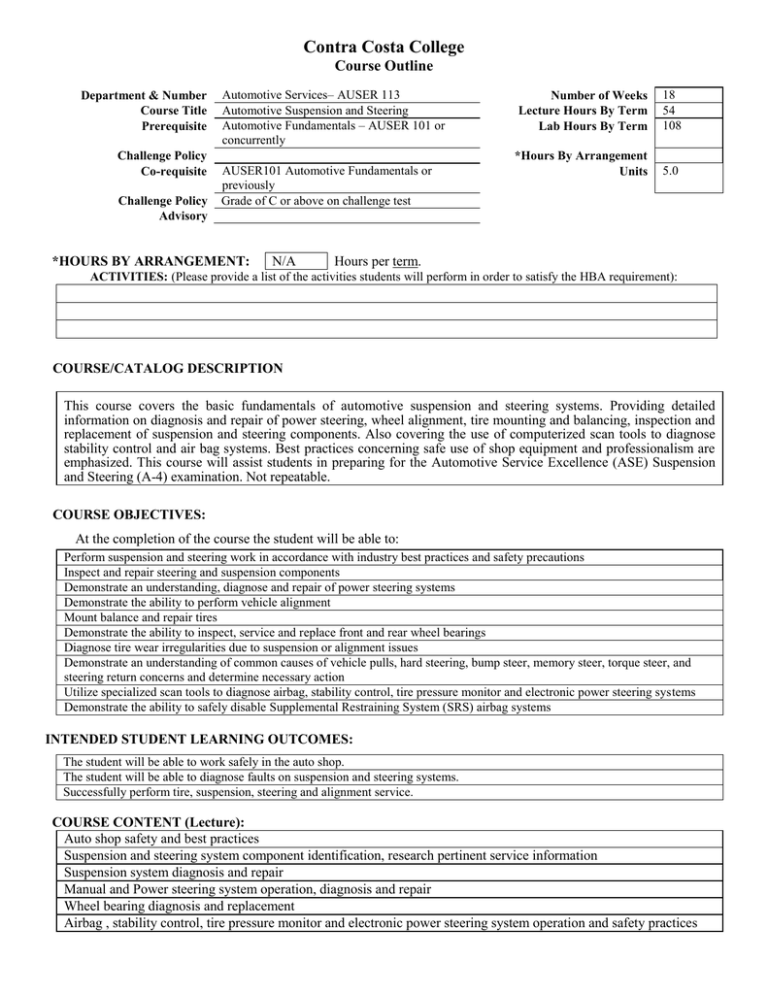
Contra Costa College
Course Outline
Department & Number
Course Title
Prerequisite
Challenge Policy
Co-requisite
Challenge Policy
Advisory
Automotive Services– AUSER 113
Automotive Suspension and Steering
Automotive Fundamentals – AUSER 101 or
concurrently
AUSER101 Automotive Fundamentals or
previously
Grade of C or above on challenge test
*HOURS BY ARRANGEMENT:
N/A
Number of Weeks
Lecture Hours By Term
Lab Hours By Term
18
54
108
*Hours By Arrangement
Units
5.0
Hours per term.
ACTIVITIES: (Please provide a list of the activities students will perform in order to satisfy the HBA requirement):
COURSE/CATALOG DESCRIPTION
This course covers the basic fundamentals of automotive suspension and steering systems. Providing detailed
information on diagnosis and repair of power steering, wheel alignment, tire mounting and balancing, inspection and
replacement of suspension and steering components. Also covering the use of computerized scan tools to diagnose
stability control and air bag systems. Best practices concerning safe use of shop equipment and professionalism are
emphasized. This course will assist students in preparing for the Automotive Service Excellence (ASE) Suspension
and Steering (A-4) examination. Not repeatable.
COURSE OBJECTIVES:
At the completion of the course the student will be able to:
Perform suspension and steering work in accordance with industry best practices and safety precautions
Inspect and repair steering and suspension components
Demonstrate an understanding, diagnose and repair of power steering systems
Demonstrate the ability to perform vehicle alignment
Mount balance and repair tires
Demonstrate the ability to inspect, service and replace front and rear wheel bearings
Diagnose tire wear irregularities due to suspension or alignment issues
Demonstrate an understanding of common causes of vehicle pulls, hard steering, bump steer, memory steer, torque steer, and
steering return concerns and determine necessary action
Utilize specialized scan tools to diagnose airbag, stability control, tire pressure monitor and electronic power steering systems
Demonstrate the ability to safely disable Supplemental Restraining System (SRS) airbag systems
INTENDED STUDENT LEARNING OUTCOMES:
The student will be able to work safely in the auto shop.
The student will be able to diagnose faults on suspension and steering systems.
Successfully perform tire, suspension, steering and alignment service.
COURSE CONTENT (Lecture):
Auto shop safety and best practices
Suspension and steering system component identification, research pertinent service information
Suspension system diagnosis and repair
Manual and Power steering system operation, diagnosis and repair
Wheel bearing diagnosis and replacement
Airbag , stability control, tire pressure monitor and electronic power steering system operation and safety practices
COURSE CONTENT (Lab):
Auto shop safety and best practices
Suspension and steering system component identification, research pertinent service information
Suspension system diagnosis and repair
Manual and Power steering system operation, diagnosis and repair
Wheel bearing diagnosis and replacement
Airbag , stability control, tire pressure monitor and electronic power steering system operation and safety practices
METHODS OF INSTRUCTION:
Shop Work
Lecture
Discussion
Demonstrations
On-line training (On-line safety and pollution training modules and exams)
INSTRUCTIONAL MATERIALS:
NOTE: To be UC/CSU transferable, the text must be dated within the last 7 years OR a statement of justification for a text beyond the
last 7 years must be included.
Textbook Title:
Author:
Publisher:
Edition/Date:
Textbook Reading Level:
Justification Statement:
Automotive Technology: Principles, Diagnosis, and Service
James D. Halderman
Pearson Prentice Hall
Fourth Edition / 2012
10.2
(For textbook beyond 7 years)
Lab Manual Title (if applicable):
Author:
Publisher:
Edition/Date:
OUTSIDE OF CLASS WEEKLY ASSIGNMENTS:
Title 5, section 55002.5 establishes that a range of 48 -54hours of lecture, study, or lab work is required for one unit of credit.
For each hour of lecture, students should be required to spend an additional two hours of study outside of class to earn one
unit of credit.
State mandates that sample assignments must be included on the Course Outline of Record.
Outside of Class Weekly Assignments
Hours per week
Weekly Reading Assignments (Include detailed assignment below, if applicable)
2
Textbook chapter reading assignments
Weekly Writing Assignments (Include detailed assignment below, if applicable)
Textbook chapter homework assignments
Weekly Math Problems (Include detailed assignment below, if applicable)
Lab or Software Application Assignments (Include detailed assignment below, if applicable)
2
Other Performance Assignments (Include detailed assignment below, if applicable)
2
Online safety and pollution modules and test
STUDENT EVALUATION: (Show percentage breakdown for evaluation instruments)
Course must require use of critical thinking, college-level concepts & college-level learning skills.
For degree credit, course requires essay writing unless that requirement would be inappropriate to the course objectives. If writing
is inappropriate, there must be a requirement of problem-solving or skills demonstration.
% Essay (If essay is not included in assessment, explain below.)
50
50
%
Computation or Non-computational Problem Solving Skills
%
%
Skills Demonstration
Objective Examinations
Other (describe)
Shop Work, Participation and Professionalism
Tests and Quizzes, Classroom Work and Homework
%
%
%
GRADING POLICY: (Choose LG, P/NP, or SC)
Letter Grade
90% - 100% = A
80% - 89% = B
70% - 79% = C
60% - 69% = D
Below 60% = F
Pass / No Pass
70% and above = Pass
Below 70% = No Pass
Prepared by: Lucile Beatty
Date: 2/17/14
Revised form 01/14
x
Student Choice
90% - 100% = A
80% - 89% = B
70% - 79% = C
60% - 69% = D
Below 60% = F
or
70% and above = Pass
Below 70% = No Pass

